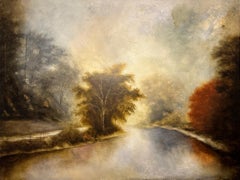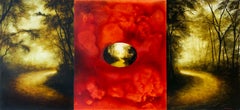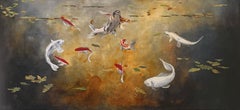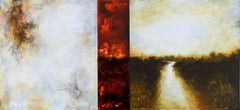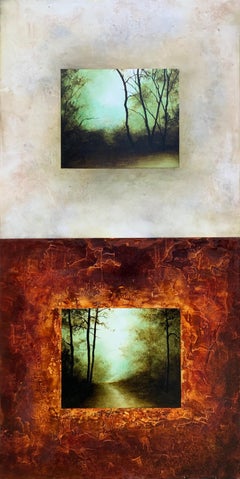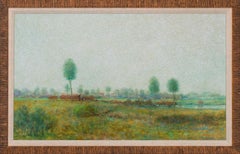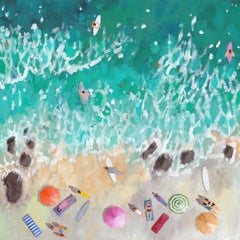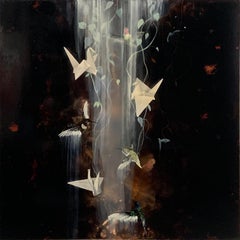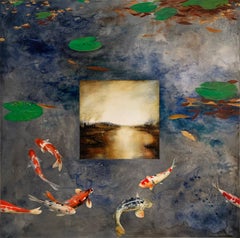Candice Eisenfeld Art
Artist Comments
A quiet river winds through a grove of trees. The warm glow at the horizon in mid-October creates a dreamlike mist and softens the scene.Artist Candice Eisenfel...
21st Century and Contemporary Realist Candice Eisenfeld Art
Acrylic
Artist Comments
A sophisticated, dreamlike view of divergent paths one can take. The middle path appearing as a painting within a painting...
21st Century and Contemporary Abstract Expressionist Candice Eisenfeld Art
Acrylic
Artist Comments
A paper crane flies among a flock of birds against a dusky warm gradient. "The title of this work, 'This Is Not a Flock of Birds,' is a nod to Belgian surrealist painter René Magritte," shares artist Candice Eisenfeld. She takes pleasure in letting her viewers create their own meanings inspired by her work.
About the Artist
As an American exploring issues of identity, artist Candice Eisenfeld paints through the lens of the first American art movement, the Hudson River School. Rather than depicting a specific locale, Candice’s artwork evokes a sense of place. These "inner landscapes" are invented, and often reference photographs taken during travels in southern Appalachia and the Blue Ridge and Smokey Mountains. Whether real or imagined, her paintings are influenced by the Dutch Masters, Tonalists, and Chinese painting. Produced on a single wooden panel, the ethereal landscapes are often joined with segments of aqueous color fields which act as commentary for the landscapes, like the chorus in a Greek play. The crisp, hard edges separating the landscapes from the color fields command a sense of order in an otherwise fluid and painterly surface. With two or three sections of the panel competing for attention, the painting creates multiple focal points. Candice's art has been displayed in embassies in Namibia and Belarus, held in the collections of Norwest Bank and Northwest...
21st Century and Contemporary Candice Eisenfeld Art
Acrylic
Artist Comments
"Considered symbols of luck, Koi fish are known for their tenacity to swim rushing streams and waterfalls until they reach their goal," says artist Candice Eisenfeld. "They are determined and they never give up. Symbolic in Buddhism, they represent courage and strength."
About the Artist
As an American exploring issues of identity, artist Candice Eisenfeld paints through the lens of the first American art movement, the Hudson River School. Rather than depicting a specific locale, Candice’s artwork evokes a sense of place. These "inner landscapes" are invented, and often reference photographs taken during travels in southern Appalachia and the Blue Ridge and Smokey Mountains. Whether real or imagined, her paintings are influenced by the Dutch Masters, Tonalists, and Chinese painting. Produced on a single wooden panel, the ethereal landscapes are often joined with segments of aqueous color fields which act as commentary for the landscapes, like the chorus in a Greek play. The crisp, hard edges separating the landscapes from the color fields command a sense of order in an otherwise fluid and painterly surface. With two or three sections of the panel competing for attention, the painting creates multiple focal points. Candice's art has been displayed in embassies in Namibia and Belarus, held in the collections of Norwest Bank and Northwest Airlines...
21st Century and Contemporary American Realist Candice Eisenfeld Art
Acrylic
Artist Comments
"Part of the meditation process is to allow your mind to clear, follow a journey, and allow thoughts to pass through," says artist Candice Eisenfeld. "The vertical, thin section in the middle is an abstracted version of the landscape, it is varnished while the other parts have no gloss. This process was done to illustrate how our perceptions of the world and experiences can change, and how we can recognize these lenses to achieve clarity. The left side depicts peaceful, floating, abstracted thoughts."
About the Artist
As an American exploring issues of identity, artist Candice Eisenfeld paints through the lens of the first American art movement, the Hudson River School. Rather than depicting a specific locale, Candice’s artwork evokes a sense of place. These "inner landscapes" are invented, and often reference photographs taken during travels in southern Appalachia and the Blue Ridge and Smokey Mountains. Whether real or imagined, her paintings are influenced by the Dutch Masters, Tonalists, and Chinese painting. Produced on a single wooden panel, the ethereal landscapes are often joined with segments of aqueous color fields which act as commentary for the landscapes, like the chorus in a Greek play. The crisp, hard edges separating the landscapes from the color fields command a sense of order in an otherwise fluid and painterly surface. With two or three sections of the panel competing for attention, the painting creates multiple focal points. Candice's art has been displayed in embassies in Namibia and Belarus, held in the collections of Norwest Bank and Northwest...
21st Century and Contemporary Abstract Candice Eisenfeld Art
Acrylic
Artist Comments
Artist Candice Eisenfeld draws inspiration from the silhouetted trees of the rainforests of Northern Georgia. "One early morning as the fog was clearing, a hawk guided me through the mountains," shares Candice. "The hawk led me through ethereal, meditative places with overwhelming beauty." She took photographs of her journey and painted her experiences of the adventure. "The bottom image depicts the rough, beginning of the journey and the scene portrays the ending. The rough, orange texture denotes the bark of the trees."
About the Artist
As an American exploring issues of identity, artist Candice Eisenfeld paints through the lens of the first American art movement, the Hudson River School. Rather than depicting a specific locale, Candice’s artwork evokes a sense of place. These "inner landscapes" are invented, and often reference photographs taken during travels in southern Appalachia and the Blue Ridge and Smokey Mountains. Whether real or imagined, her paintings are influenced by the Dutch Masters, Tonalists, and Chinese painting. Produced on a single wooden panel, the ethereal landscapes are often joined with segments of aqueous color fields which act as commentary for the landscapes, like the chorus in a Greek play. The crisp, hard edges separating the landscapes from the color fields command a sense of order in an otherwise fluid and painterly surface. With two or three sections of the panel competing for attention, the painting creates multiple focal points. Candice's art has been displayed in embassies in Namibia and Belarus, held in the collections of Norwest Bank and Northwest...
21st Century and Contemporary Contemporary Candice Eisenfeld Art
Acrylic
Artist Comments
Artist Candice Eisenfeld presents a painting within a painting emanating warmth and light from the middle. "These paintings are meant to explore levels of meaning as they connect our personal experiences to a world severely distanced from ourselves," states Candice. Her interest lies in understanding what is at the core of human nature—desire, curiosity, love, and hope. "It is narrating a personal archeology of the id while simultaneously relating to other people what is timelessly universal."
About the Artist
As an American exploring issues of identity, artist Candice Eisenfeld paints through the lens of the first American art movement, the Hudson River School. Rather than depicting a specific locale, Candice’s artwork evokes a sense of place. These "inner landscapes" are invented, and often reference photographs taken during travels in southern Appalachia and the Blue Ridge and Smokey Mountains. Whether real or imagined, her paintings are influenced by the Dutch Masters, Tonalists, and Chinese painting. Produced on a single wooden panel, the ethereal landscapes are often joined with segments of aqueous color fields which act as commentary for the landscapes, like the chorus in a Greek play. The crisp, hard edges separating the landscapes from the color fields command a sense of order in an otherwise fluid and painterly surface. With two or three sections of the panel competing for attention, the painting creates multiple focal points. Candice's art has been displayed in embassies in Namibia and Belarus, held in the collections of Norwest Bank and Northwest Airlines...
21st Century and Contemporary Abstract Candice Eisenfeld Art
Acrylic
Artist Comments
Power lines extend into the fog, creating a quiet landscape that merges the chaos of human creation and the calmness of nature. Isolated from the noise of the modern world and moments of reflection, utility poles support the electrical veins of society within a calm, natural setting. Opposite realities can coexist, creating beauty in the spaces where they meet. The artwork has a matte, low-sheen finish, which allows clear viewing in various lighting conditions.
About the Artist
As an American exploring issues of identity, artist Candice Eisenfeld paints through the lens of the first American art...
21st Century and Contemporary Contemporary Candice Eisenfeld Art
Acrylic
Artist Comments
Candice was deeply inspired after a visit to Yellowstone National Park. The central landscape image was created using a photographic transfer method while the landscapes on either side were created with paint applications. "The abstracted compositional areas serve as windows or doors to memories, to secrets, to hidden worlds," Candice says.
About the Artist
Words that describe this painting: forest, pine trees, hudson river school, lock and key...
21st Century and Contemporary Candice Eisenfeld Art
Acrylic
Artist Comments
Symbols of home and family juxtaposed with adventure, discovery and flight are re-occurring themes in Candice's work. A hummingbird boldly flies away from its...
21st Century and Contemporary Candice Eisenfeld Art
Acrylic
Artist Comments
A stand of trees on a hill overlooking a pond during a sunny day with blue skies. The scene is framed with a deep red abstraction characterized by a very thic...
21st Century and Contemporary Abstract Candice Eisenfeld Art
Acrylic
Artist Comments
The artwork depicts a serene and meditative composition, blending abstraction with landscape photography. The textured white field envelopes an oval image remi...
21st Century and Contemporary Abstract Candice Eisenfeld Art
Mixed Media
1980s Realist Candice Eisenfeld Art
Acrylic, Canvas
21st Century and Contemporary Realist Candice Eisenfeld Art
Canvas, Acrylic
19th Century Impressionist Candice Eisenfeld Art
Oil
21st Century and Contemporary Abstract Expressionist Candice Eisenfeld Art
Oil Pastel, Acrylic, Carbon Pencil, Color Pencil
21st Century and Contemporary Abstract Expressionist Candice Eisenfeld Art
Oil Pastel, Acrylic, Carbon Pencil, Color Pencil
21st Century and Contemporary Abstract Expressionist Candice Eisenfeld Art
Oil Pastel, Acrylic, Carbon Pencil, Color Pencil
21st Century and Contemporary Abstract Expressionist Candice Eisenfeld Art
House Paint, Acrylic, Carbon Pencil, Oil Pastel, Color Pencil
19th Century Barbizon School Candice Eisenfeld Art
Oil
21st Century and Contemporary Abstract Expressionist Candice Eisenfeld Art
Acrylic
21st Century and Contemporary Realist Candice Eisenfeld Art
Canvas, Acrylic
Early 19th Century Barbizon School Candice Eisenfeld Art
Oil
2010s Contemporary Candice Eisenfeld Art
Ink, Watercolor, Archival Paper, Crayon, Wax, Acrylic, Color Pencil
Sophia Milligan'Towards Le Scathe Cove'. Contemporary Landscape, Rural, Sea, Ocean, Beach Blue, 2022
Artist Comments
Artist Candice Eisenfeld shares the myth of The Dancing Birds and the Flood, "A young shepherd in China interpreted the dances of birds in the sky. He warned the elders in his region about a looming flood, but no-one believed him. Taking matters into his own hands, he made 1000 cranes from paper, working for weeks with little sleep with the wish to keep his townspeople safe. When the floods came, his town was spared heavy destruction while nearby villages were swept away. The young shepherd was later called Yu the Great."
About the Artist
As an American exploring issues of identity, artist Candice Eisenfeld paints through the lens of the first American art...
21st Century and Contemporary Contemporary Candice Eisenfeld Art
Acrylic
Artist Comments
A surreal painting within a painting. In the middle of a peaceful koi pond appears a window to a soft autumn landscape. "I began this painting in 2005 and hav...
21st Century and Contemporary Abstract Candice Eisenfeld Art
Acrylic
